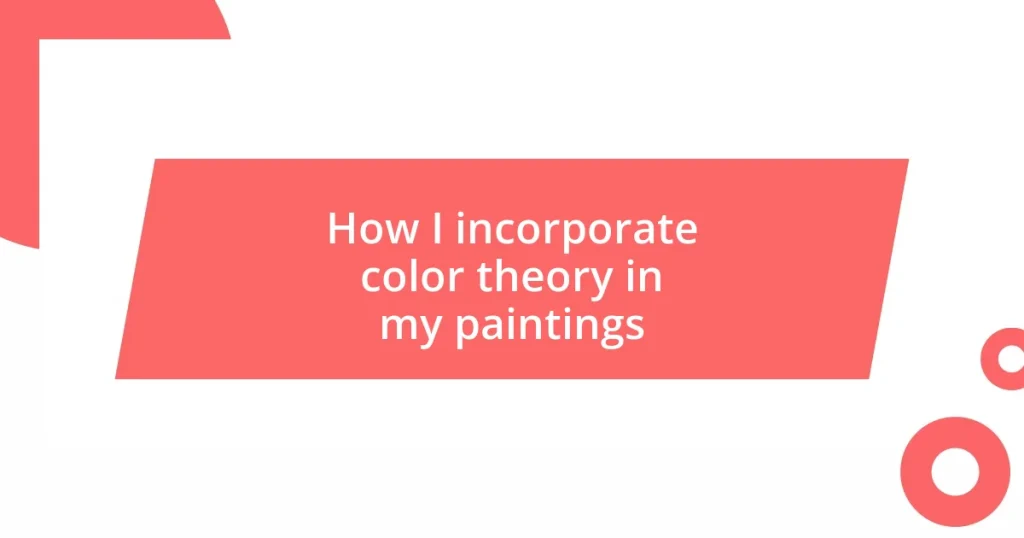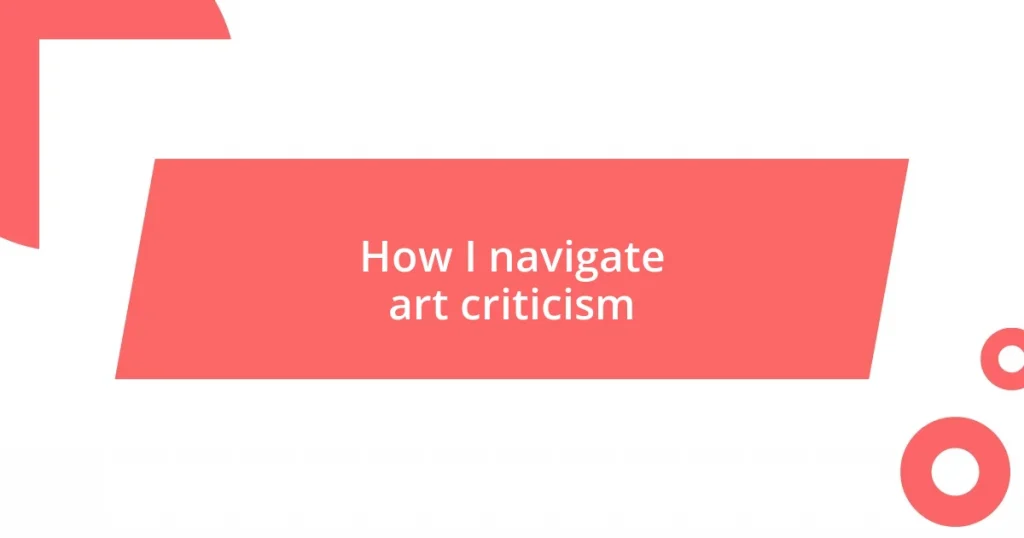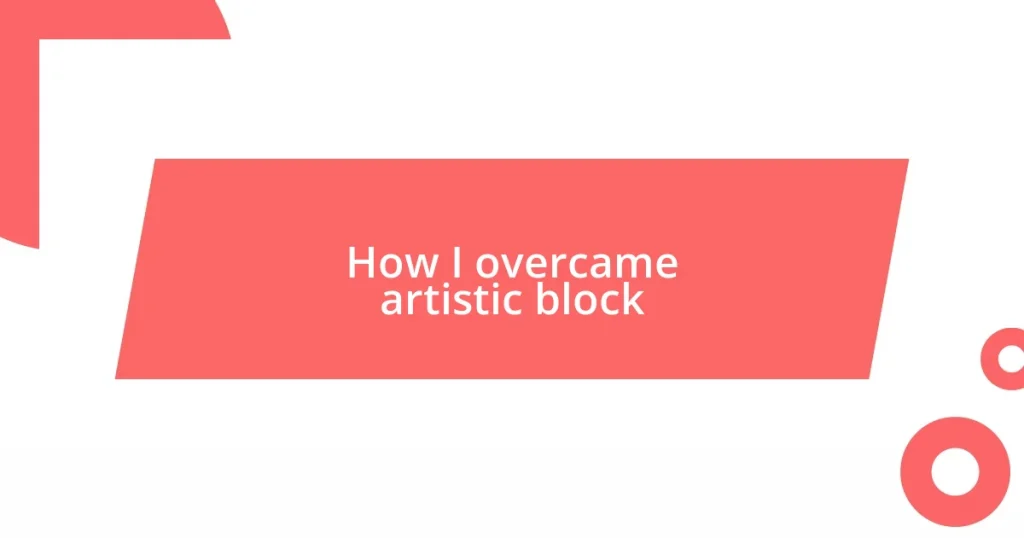Key takeaways:
- Understanding color theory is essential for expressing emotions in artwork, with warm colors evoking passion and cool colors fostering calmness.
- The color wheel helps artists explore relationships between colors, such as complementary and analogous colors, enhancing visual harmony and impact.
- Evaluating color choices is a personal journey, benefiting from reflection and collaboration with others to improve cohesion and emotional resonance in art.
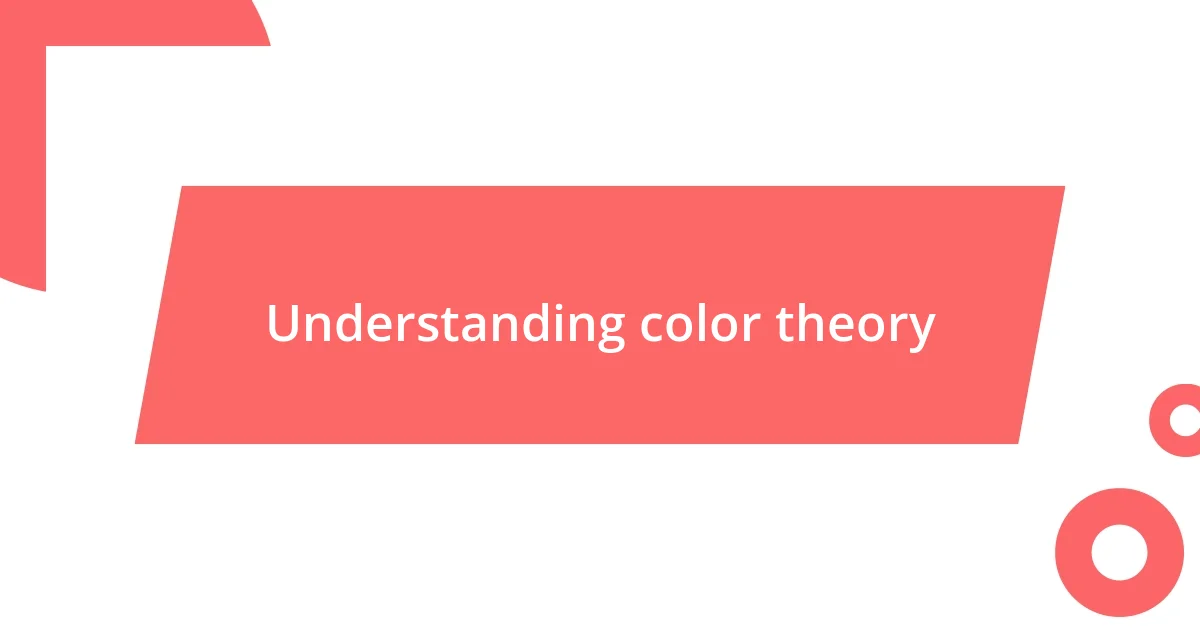
Understanding color theory
Color theory is a fascinating framework that helps us understand how colors interact and the emotions they evoke. I remember the first time I created a piece using complementary colors—orange and blue. The energy was electric; it felt like a dance on the canvas, sparking joy and excitement. Have you ever noticed how certain color combinations can completely shift your mood?
As I delved deeper into color theory, I discovered the emotional impact of warm and cool colors. Warm colors, like reds and yellows, often bring warmth and passion, while cool colors, such as blues and greens, evoke calmness. One day, I painted a sunset using a warm palette, and I felt a rush of happiness every time I looked at it. Isn’t it incredible how color choices can reflect our own feelings and experiences?
There’s also the concept of color harmony, which refers to attractive color combinations that are visually pleasing. I often experiment with triadic color schemes, which involve three equally spaced colors on the color wheel. The first time I tried this approach in my art was both exhilarating and a bit daunting. I loved seeing how these vibrant choices could create a dynamic yet balanced composition. Have you explored the role of color harmony in your own artwork? It can truly transform your approach to painting.
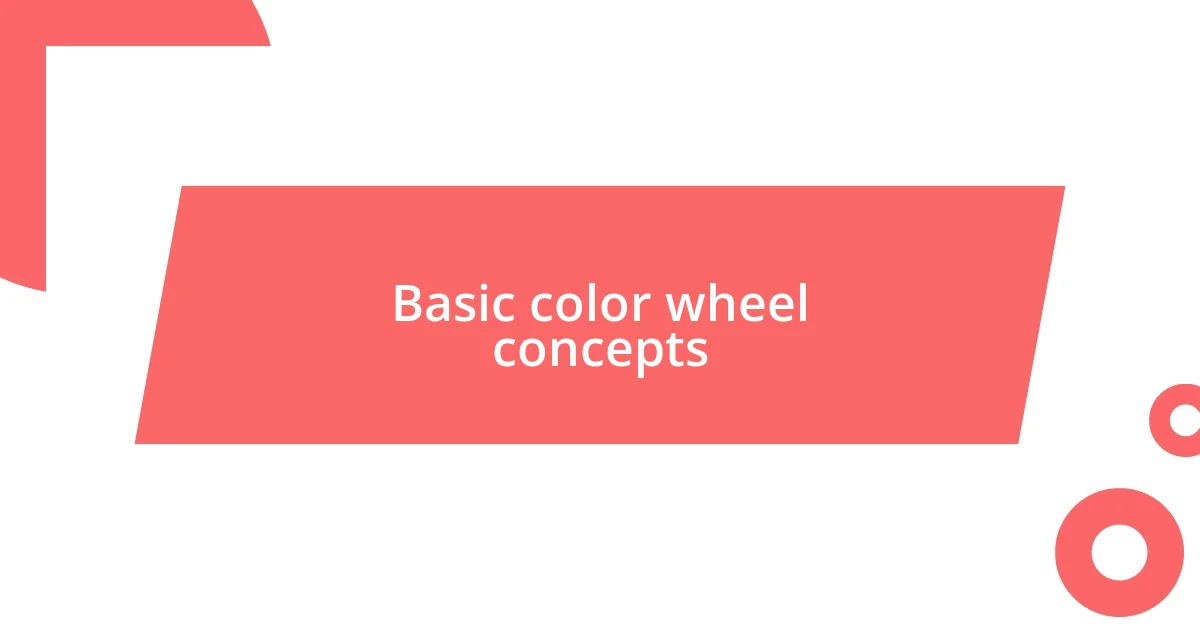
Basic color wheel concepts
The color wheel is a fundamental tool that encapsulates the relationships between colors. It’s fascinating how primary colors—red, blue, and yellow—serve as the foundation for creating other colors. I recall the first time I set out to mix secondary colors, like green from blue and yellow; watching those hues come to life felt like magic on my palette. Each blend reminded me of a cherished garden in spring, bursting with vivid colors.
Understanding the color wheel also introduces you to the concepts of complementary and analogous colors. Complementary colors, positioned directly across from each other (like red and green), create a striking visual tension. When I added flashes of complementary hues in one of my landscape paintings, it made the scene leap off the canvas—it was as if the colors were in dialogue. Conversely, analogous colors—those next to each other, like blue, blue-green, and green—offer a more harmonious feel, often evoking tranquility. I once experimented with an analogous palette for a serene seascape and felt enveloped in calmness as I painted.
Moreover, the color wheel guides the exploration of color temperature. Warm colors, such as oranges and reds, often bring intensity and vibrance, while the cooler hues evoke serenity and depth. I distinctly remember painting a room bathed in warm sunlight, using a palette that mirrored the energy around me; it felt like capturing a moment in time. My experiences with color truly remind me of how closely linked our emotions are with our choices in pigments.
| Color Category | Description |
|---|---|
| Primary Colors | Base colors that cannot be created by mixing other colors (red, blue, yellow). |
| Secondary Colors | Colors made by mixing two primary colors (green, orange, purple). |
| Complementary Colors | Colors directly opposite each other on the wheel (red-green). |
| Analogous Colors | Colors that are next to each other on the wheel (blue, blue-green, green). |
| Warm Colors | Colors that evoke warmth (reds, oranges, yellows). |
| Cool Colors | Colors that evoke calmness (blues, greens, purples). |
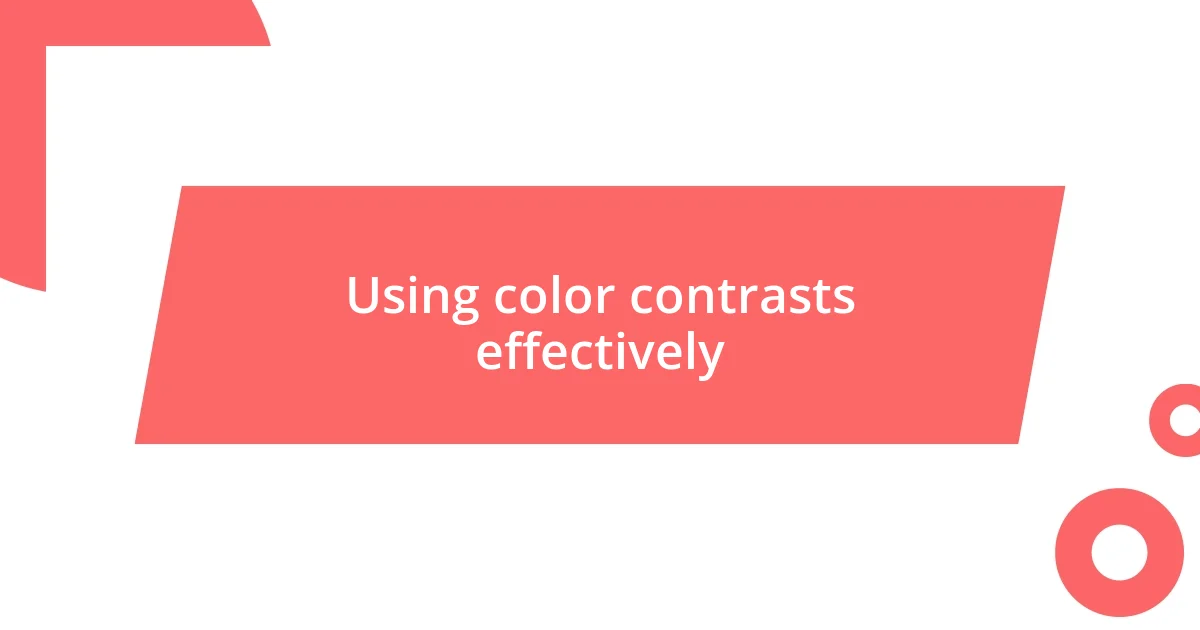
Using color contrasts effectively
Using color contrasts effectively can bring depth and dynamism to my paintings. One of my favorite techniques is to juxtapose light and dark shades, which instantly creates a dramatic impact. I remember trying this with a portrait I painted last summer—by using deep navy against brighter coral, the subject seemed to almost leap off the canvas, enhancing the emotion in her expression. It’s fascinating how contrasting values can guide the viewer’s eye and highlight key elements of a piece.
- Complementary Colors: Placing them side by side intensifies each hue. For example, a vibrant yellow against a cool purple can create visual excitement.
- Value Contrast: Using a range from light to dark can add dimensionality, much like how sunlight reflects off different surfaces.
- Temperature Contrast: Mixing warm and cool colors together—not just for beauty but to evoke specific moods, like the heat of a sunset contrasting with the cool of early twilight.
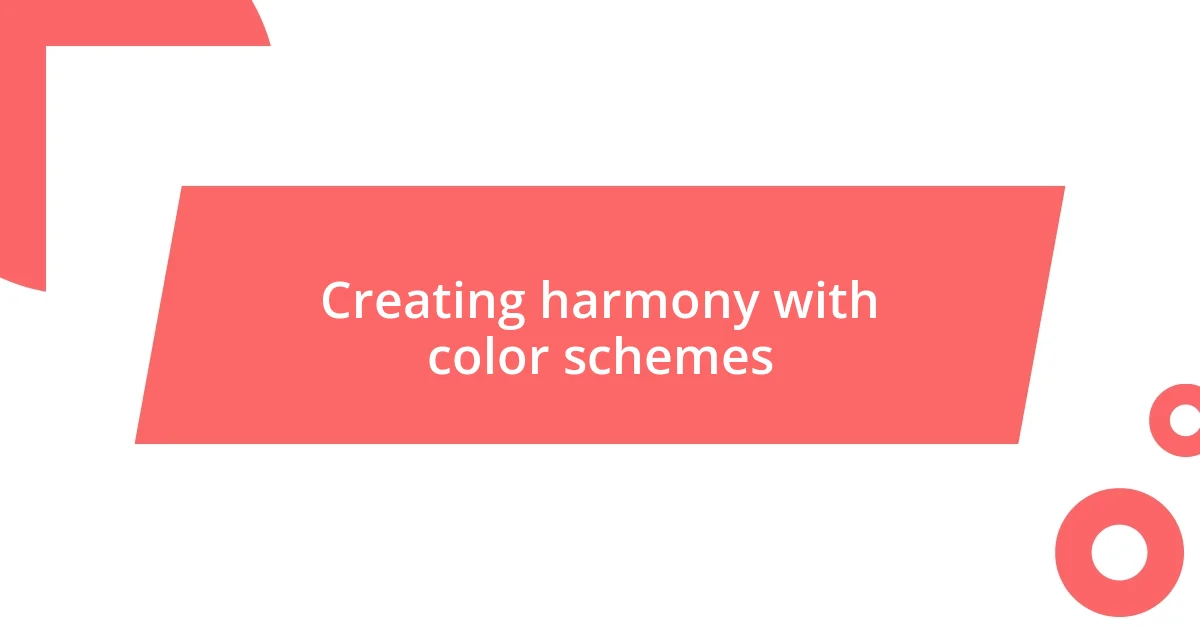
Creating harmony with color schemes
Creating color harmony in my paintings often revolves around effective color schemes that resonate with the viewer. I find that limiting my palette to a few colors can help cultivate a sense of unity. For instance, in a recent piece inspired by autumn foliage, I chose various shades of orange and yellow, woven together with subtle hints of brown. The result was a cohesive landscape that felt like a warm embrace, where each color danced together instead of competing for attention.
When working with complementary colors, I usually think about balance. One of my favorite experiments involved painting a vibrant sunset. Using bright oranges against soft blues not only highlighted the intensity of the sky but also evoked a feeling of calmness that often accompanies sunset moments. Have you ever noticed how those warm and cool colors can create a fusion of emotions, leaving you with a lingering sense of peace? That’s the symbiosis I aim for in my artwork.
Analogous color schemes have also become a staple in my creative process. By selecting colors that sit next to each other on the wheel, I can create a soothing harmony. I vividly remember a painting session where I focused on various shades of green and yellow for a lush garden scene. This choice not only complemented the subject but also conveyed a sense of serenity, transportable to anyone who might view it. The visual flow directed eyes through the painting, allowing emotional connection to flourish.

Practical exercises for applying color
One of my go-to exercises for applying color is the “monochromatic study.” I choose a single color and explore its various shades and tints, using only that hue in my artwork. It’s fascinating to see how a simple blue can shift from soft and serene to bold and intense just by altering the lightness or darkness. Working on a monochromatic piece helped me appreciate the subtle complexities within one color, and it opened my eyes to how emotions can be communicated with just that single hue.
Another technique I’ve found invaluable is creating color thumbnails. These are small, quick sketches where I can experiment with different color combinations before committing to a larger canvas. I remember one instance when I threw together a series of vibrant thumb sketches using unconventional color pairings. The surprise emerged when I discovered an unexpected love for using bright pink next to deep green. Who would have thought they could create such a lively atmosphere together? It’s a playful way to explore possibilities and challenge my usual color choices.
Have you ever tried a color wheel exercise? I often use a color wheel to select a color and then challenge myself to incorporate its complementary hue into a small painting. This hands-on approach reminds me that color theory is not just a rulebook; it’s a playground for creativity. One of my favorite projects involved this exercise with a vibrant red and its green counterpart, making the whole piece feel alive and festive. By pushing my limits, I consistently uncover new interactions and relationships between colors, enriching my artistic journey.
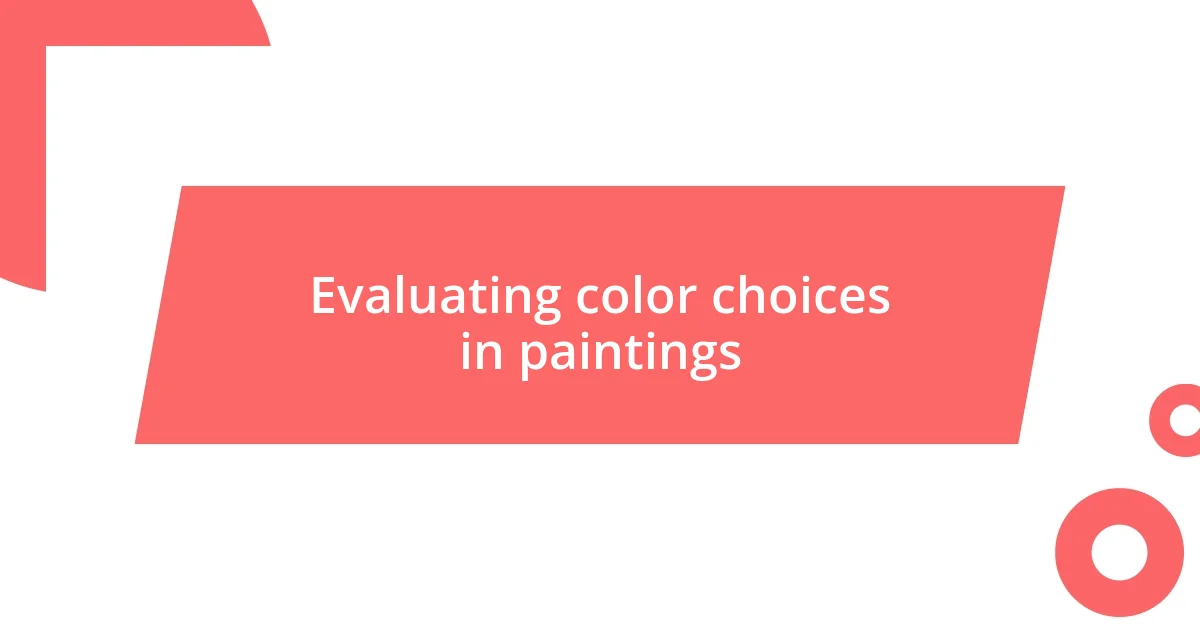
Evaluating color choices in paintings
Evaluating color choices in paintings often becomes a deeply personal journey for me. I remember staring at a finished piece—its colors felt off, despite my meticulous selection process. It prompted a moment of reflection: how can color truly convey the emotions I intend? In that instance, I decided to take a step back and analyze each hue’s emotional weight, realizing how critical it is to evaluate what each color adds to the overall message of my artwork.
Sometimes, I trust my instincts by revisiting my color choices after some time away from the canvas. I recall a specific painting where I originally used a bright pink that now seemed too jarring. When I stepped back, I replaced it with a softer peach that seemed to whisper rather than shout. This small adjustment transformed the piece, enhancing its inviting quality. Have you ever revisited your color choices and felt a new perspective bubbling forth? That fresh take can be illuminating, revealing layers you hadn’t noticed before.
Collaborating with other artists also helps sharpen my evaluation process. I vividly recall a studio session where a fellow painter brought her insights to my color palette. She pointed out that the greens I used were fighting against the warm undertones I’d applied. Listening to her perspective opened my eyes to harmonizing those contrasting shades to enhance the overall cohesion of the piece. It’s fascinating how external input can help us reassess our color choices, isn’t it? This kind of dialogue enriches my artistic practice immensely.










